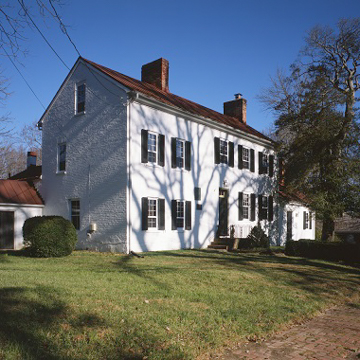Coexisting with Sandy Spring’s rural agrarian landscape is the former market town of Brookeville, encompassing mills powered by a tributary of the Patuxent. Its establishment reflected the social and economic transformation of rural communities that occurred nationwide during the post-Revolutionary War period. By 1813, Brookeville included two mills, a tan yard, stores, a post office, a blacksmith shop, a school, and fourteen houses. Expanding during the nineteenth century, by 1880 it boasted the third largest population in Montgomery County. Now a quiet residential community, it encompasses a range of building styles nestled within an idyllic, rolling landscape.
Noteworthy is the Madison House (c. 1798; 205 Market Street), a Federal-style two-story brick residence with a wing that housed the town’s first store and post office. The name references its role as refuge to President James Madison during the War of 1812 British invasion of Washington. The neighboring Italianate house (c. 1850; 207 Market) was built for physician Artemus Riggs, encompassing his brick office to the rear. A Federal side-hall-plan brick house (c. 1801; 307 Market) was built for the town’s blacksmith. David Newlin’s simple, one-room and loft stone house (c. 1800; 318 Market), later significantly enlarged, sat adjacent to his former mill.
Built c. 1800 to attract skilled workers are three hall-parlor cottages, banked into the hillsides to provide a ground-level kitchen, with the formal room on the main level and loft above. The cottage (203 Market) erected for Richard Thomas’s millhand is of stone while the other two cottages, (198 and 313 Market), are of frame and log construction, respectively.
The stone Brookeville Academy (c. 1810; 5 High Street), built as a boys’ private school, is now the community meeting hall, and the quintessential one-room Brookeville Public School House (c. 1865; North Street) is one of the only original seventy frame schoolhouses in Montgomery County by 1880 to survive.


